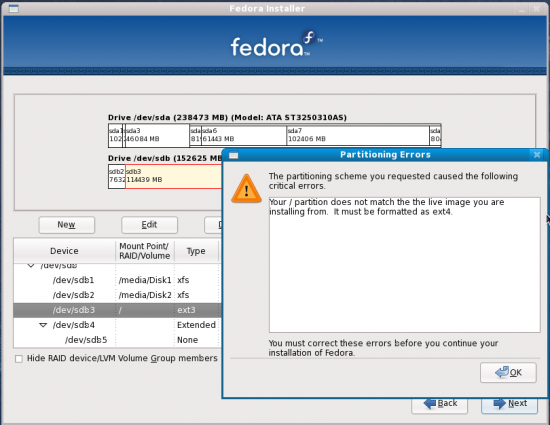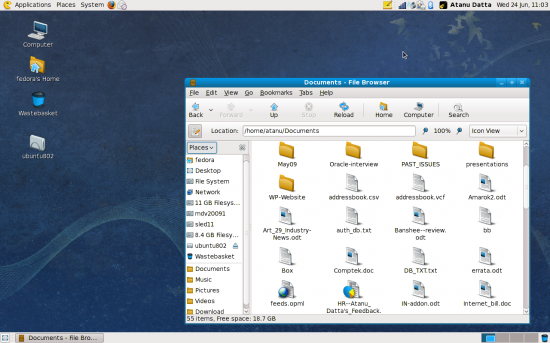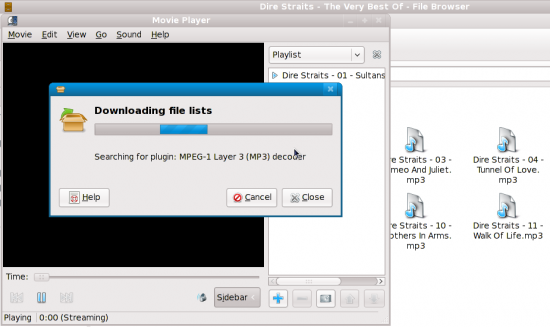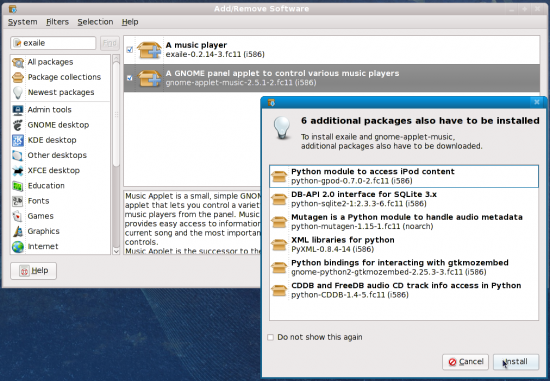A 20-second boot, Ext4 as default filesystem, Firefox 3.5 and Thunderbird 3.0, OpenOffice.org 3.1, Delta RPM support, better support for fingerprint readers, automatic fonts and mime installer… Well, these were some of the 50 odd features listed on the project website when the Fedora 11 development was taking shape. The good news is, when the final release was out, the status for all these listed features was 100 per cent. Impressive, eh?
Naturally, the next step was to head over to fedoraproject.org and download the ISO. As is the norm with any other distro, Fedora 11 (codenamed Leonardo Leonidas) comes as an installable DVD, or live CDs of various spins, including GNOME and KDE. I chose GNOME (for a change), because features such as automatic codec and mime installation are reportedly GNOME-only for this release. Talk about treating KDE as your step child ;-)
The test systems
An HP 550 laptop with the following specs:
- Intel Core 2 Duo T5470 (1.6 GHz, 800 MHz FSB, 2 MB L2 cache)
- 1 GB 667 MHz DDR2 SDRAM
- 160 GB 5400 rpm SATA
- Mobile Intel GMA X3100 graphics
An assembled AMD-based desktop with the following specs:
- AMD Athlon X2 5600+ Dual Core (2.8 GHz, 2000 MHz HyperTransport, 1 MB L2 Cache)
- 2 GB 800 MHz DDR2 SDRAM
- 250 GB 7200 rpm SATA + 160GB 7200 rpm PATA
- NVDIA 7050 PV (integrated graphics inside an ASUS M2N-VM DVI MoBo)
Test drive on a live CD
Since the kernel modesetting (KMS) works on Intel (as well as ATI) graphics cards, but not on NVIDIA by default, I booted the HP laptop first. KMS is the backbone of Plymouth, the replacement for RHGB for boot splash, which helps in a flicker-free X server initialisation. While booting the live CD, I noticed the new splash screen—the Fedora infinity logo. You see the magic of KMS when GDM loads after the initial boot—the transition effect is, in fact, smooth. You understand the point that Fedora developers are trying to make when they say: “The start-up experience needs to be flicker-free, seamless and shiny.”
On the GDM screen, I also noticed what I believe is the new option for logging in using a finger impression, provided you have a fingerprint reader. I don’t, so I couldn’t test this one.
After logging into the desktop, you’re greeted by the excellent Fedora wallpaper—I loved it for the first time since the project’s inception. It has that professional touch that was always missing. Apart from this, things look pretty much the same visually. It’s the same GNOME 2.6 that we already know of from the Ubuntu and Mandriva Spring releases. The icon set, dubbed Fedora, is the plain old customised theme that made its debut with Fedora 7. Whatever happened to the Echo theme?
A change that I noticed is the new volume control tool. This one gets rid of the separate GNOME ALSA mixer and the one offered by PulseAudio, and integrates everything at one place. It makes sense to control all volumes from one location, but the application lacks the amount of mixers present in the ALSA mixer.
What’s quite discouraging to see is the lack of applications on the live CD. OpenOffice.org is missing, and so is a general digital camera/photo manager application like F-Spot. Well, of course, these can be installed from the online repository, but what is it that fills up the 687MB CD that leaves no room for OOo (which is present by default on all other live CD distros)? The Fedora team says it chooses to support a more complete set of languages that takes up the space as compared to others supporting only English (US). Good enough reasoning, but I guess if you choose to use another localisation setting, it’s a smaller download compared to OOo’s size, which most people will anyway need. The provided AbiWord as a replacement word processor is no solution at all.
Installation notes
Well, time to install the distro. The live installer, I gotta admit, is snappy. The only downside: you don’t have a say in the filesystem you’d like to use for your root. Fedora defaults to ext4. We’ve all heard a lot about data loss in this new FS when a computer is not properly shut down or if the OS crashes—a problem also common with XFS. Ext3, that way, has always been a safe bet. The kernel developers have obviously taken note of the complaints and patches to cure this have been included in version 2.6.30. Fedora, however, ships with 2.6.29, but the developers have reportedly backported these patches to its kernel.
I’d say, good job there. However, I have serious issues with giving the user no choice apart from ext4 for his root FS. The reason being, as I’ve been told, live CDs don’t have the ability to change filesystems. Essentially, they transfer a single pre-formatted image to the disk and write a boot loader on the system at the end of the process. You can, however, choose your own FS if you’re using the installable DVD. Well, other live systems—viz., Ubuntu, Mandriva, openSUSE—surely let you select your own FS even when you install from live CDs.
Anyway, ext4 it is. The problem again is, it’ll force you to create a separate /boot partition of ext3 type, because GRUB still doesn’t have support for ext4. Anyway, enough with the complaints, the installer manages to copy the whole system within 5 to 6 minutes, which I gotta admit is amongt the fastest.

LFY, on the other hand, chose to bundle the DVD for being a more complete package. I got access to the DVD a bit later, which prompted me for fresh install on my assembled desktop PC. Anaconda behaves pretty much the same way, with all the options remaining the same. I still have issues with the partition screen where, by default, it’s set to erase all your partitions. You must select to manually set the partitions from the drop down, unless you’re using a blank hard disk.
While the installation using the live CD was faster compared to the other distros, the installable DVD took a lot of time installing packages. It took more than half-an-hour with the default choice of packages—the only thing that I had added to it were the packages under the virtualisation section. What I’ve noticed with Anaconda over the last few releases is that it starts off installing the packages at good speed, and then gradually slows down irrespective of the package size that it’s installing.
Back to the desktop
Booting up the brand new system, I notice the flicker-free X server initialisation missing because of being on a system with an NVIDIA chipset. The good thing is Fedora now uses the free Nouveau drivers for NVIDIA instead of NV—we all knew how unreliable NV was, right? I remember Fedora 10 live CD won’t even start the X server; F11, on the other hand, even lets me use the maximum resolution of 1280×1028 using Nouveau.
Oh yes, the DVD installation gave me a more complete GNOME desktop, including OOo and F-Spot. Talking about OOo, its icons are still the ones that appeared with the release of Red Hat 8 back in 2002, and they are ugly.
Anyway, time to see what else is there on the DVD. Alas, the PackageKit/Yum interface doesn’t include the DVD as a source by default and expects you to download the packages even if they are available on the DVD. Talk about waste of bandwidth and time. What’s worse, the GUI doesn’t give you an option to add it. Heck, even a simple option to add a proxy is missing.
The only option it lets you have control over is checking boxes to enable/disable the repositories. I understand this is adequate if you’re only interested in adding third-party repos like RPM Fusion. You can simply head over to the website and install the RPMs for free and non-free repos, and it will automagically configure and enable the repos in your sources. But what if you’re behind a proxy or want to add the DVD as a source? Well, then you’ve got to manually edit some files.
Here’s how you add the DVD as a source—as root, create a file called /etc/yum.repos.d/fedora-dvd.repo and enter the following text in it:
[fedora-dvd] name=Fedora 11 DVD baseurl=file:///media/Fedora%2011%20i386%20DVD/ enabled=1 gpgcheck=0
That’s it! Now the package manager is intelligent enough to not download the packages that are already on the DVD.
And here’s how you set up Yum/PackageKit to use a proxy—append the following text in the /etc/yum.conf file:
#The proxy server - proxy server:port number proxy=http://MyProxyURL:PortNumber #The proxy user name and password proxy_username=MyUserName proxy_password=MyPassword
Of course, fill in your appropriate proxy URL/IP, port number, user name and password details above.

So, the first thing I did was install the Echo icon theme. Although, it’s not a finished product, it’s still gorgeous! Next thing was to test how the auto mime installation works. I headed over to my music folder and double clicked on an mp3 file. It automatically prompted me to press ‘Search’ to look for appropriate codecs, and returned gstreamer-ugly-plugins soon. Somehow, I wasn’t so lucky with AVI files.

Still on the subject of PackageKit and Yum, I think it’s rather slow in figuring out dependencies or even searching packages. I’m sure those from the apt-get wonderland would be disappointed here. Heck, I even find Mandy’s urpmi and openSUSE’s zypper faster.
To end the discussion on package managers, the 11th edition of Fedora also officially supports delta RPMs, thanks to the Presto Yum plug-in, although this is not enabled by default. Install it by executing: yum install yum-presto.

You must be aware delta RPMs are a great way to save on your bandwidth traffic. This is because when updates are made available for any package, the package manager only needs to download what has changed in the new release since the last time (aka the diff patch). However, please note, it will only work if the said repository supports delta RPMs.
Coming back to applications, we all know the needs of users vary significantly. However, Fedora, just like other distros, has done a pretty decent job of selecting the defaults. And if you need more, you have the DVD and the online repos.
I installed the kmod-nvidia-185.14.18-1 package (a metapackage with tracks nvidia kernel modules for newest kernels) and restarted X. My resolution went back to 1024×768 from 1280×1024. Up on trying to launch the system-config-display tool from the command line, I got the following error:
Traceback (most recent call last): File "/usr/share/system-config-display/xconf.py", line 376, in dialog = xConfigDialog.XConfigDialog(hardware_state, xconfig, rhpxl.videocard.VideoCardInfo()) File "/usr/share/system-config-display/xConfigDialog.py", line 641, in __init__ if len(self.xconfig.layout[0].adjacencies) > 1: IndexError: index out-of-bounds
Up on searching the Web, I found a bug report at Red Hat Bugzilla. Solution from the Fedora forum that I got was to delete the /etc/X11/xorg.conf file and then launch system-config-display. Although it loads up now, it doesn’t allow me to go beyond 1024×764 px.
Switching from init 5 to init 3, and launching system-config-display lets me change the resolution back to 1280×1024 px, but back on the desktop Compiz reports 3D isn’t supported.
Up on various trial-and-errors and being still unable to resolve it, I thought I was better off with the free Nouveau drivers.
One thing I’d like to mention here is the decision to include Firefox 3.5. Well, it’s still a beta release, but nonetheless, it’s working like a charm on my installations. The new version debuts with the private browsing feature—you can access it from Tools—>Start Private Browsing. The immediate result is, Firefox saves and closes all the currently open tabs, and pulls up a new empty window with the following info: “In a Private Browsing session, Firefox won’t keep any browser history, search history, download history, web form history, cookies, or temporary internet files. However, files you download and bookmarks you make will be kept.” In addition, there’s more fine-grained control over clearing your browser history—you can choose to delete the history for an hour, two hours, four hours, today’s, or everything. Additionally included is Thunderbird 3.0 beta, which finally comes with an outbox :-)
Overall
Although the overall experience with Fedora looks to be quite disappointing, it’s also a pleasure running it—where else would you be able to check on the latest features that are awaiting you? Fedora 11 still proves to be among the most innovative GNU/Linux distros. The only thing missing is proper usability checks on essential features/options people come to expect from their desktop OS. Then again, we’ve too many distros that cater to the usability aspect to make GNU/Linux acceptable as a desktop OS by the next generation of users.
Critics often say Fedora is the test bed for Red Hat Enterprise Linux. I’d like to differ and point out that Fedora is, in fact, the test bed for most, if not all, GNU/Linux distros.
Ratings
- Installer: 3/5
- Ease of use: 3/5
- Features: 4/5
- Stability: 4/5
- Community: 4.5/5
- Overall: 3.5/5
Resources
Update: The headline of this article wrongly quoted the Fedora 11 release name as Leonardo previously. The incorrect release name has also been published in the July 2009 issue of the magazine. The reviewer regrets the error.




Looks nice.. I won't be reading it now :P Will read it from the magazine itself.
I heard Leonidas was another failure .. I would give it a try just for Plymouth, though I am sure it won't as ATI open source driver has just merged KMS in kernel 2.6.31 which is not likely to be included in F11..
Judging by the rating it ok .. Nothing fancy to be used.. the only led down is the repositories, even with rpmfusion I don't find as many software as Mandriva, Ubuntu and Arch Linux.
It should be Leonidas – that's the release name.
– sankarshan at fedoraproject dot org
I guess I goofed up while delving over an apt headline. Anyway, have corrected the codename in the this version, but letting the headline be.
[…] Fedora 11: Leonidas Roars for Attention – LINUX For You Magazine […]
[…] Excerpt from: Fedora 11: Leonidas Roars for Attention – LINUX For You Magazine […]
Fedora core11 appeared utter disappointment for me. five times, it flawed my winxp in a dual boot installation. EarlierI could install FC9 much easily and there were no issues. finally i had to go to the PC repair shop to get my winXP restored.
I fear whether there were some issues with the distro supplied by LFY and whether they would chack it up and plan to supply a replacement instead.
“Flawed [your] winXP” as in? Do you mean it erased you XP partition or didn't list it in Grub?
The distro supplied by LFY is a the same ISO available in fedoraproject.org w/ zero modifications. :-)
after completing installation, it wanted to reboot. while re booting, it took a path to another hard disk where FC9 was present.
the other disk was not in master, in the boot sequence.
and even if i removed the old disk, the FC11 did neither finish its jobs after first installation like setting peripherals , nor it allowed me a way to select the WinXP ( property of GRUB). after boot sequence, it used to show up a blinking horizontal cursor at the top left.
i had to reach my PC support person who managed to enter some boot correction and restored my PC. while there they also tried to install the FC11 but same observation.
Regards
Sarma
“Flawed [your] winXP” as in? Do you mean it erased you XP partition or didn't list it in Grub?
The distro supplied by LFY is a the same ISO available in fedoraproject.org w/ zero modifications. :-)
after completing installation, it wanted to reboot. while re booting, it took a path to another hard disk where FC9 was present.
the other disk was not in master, in the boot sequence.
and even if i removed the old disk, the FC11 did neither finish its jobs after first installation like setting peripherals , nor it allowed me a way to select the WinXP ( property of GRUB). after boot sequence, it used to show up a blinking horizontal cursor at the top left.
i had to reach my PC support person who managed to enter some boot correction and restored my PC. while there they also tried to install the FC11 but same observation.
Regards
Sarma
Installed today, nothing great.
Kubuntu works better!!!!!!!
One thing you failed to mention, that I found highly disappointing, is not only does the Fedora 11 installer default to ext4 for the file system, but there is no option anywhere for ReiserFS – anywhere in the installer. My old /home is on ReiserFS, the one I was trying to mount in the installation, and it wouldn't even mount.
I had installed over Mandriva Cooker, just formatting / (root), and it decided to create its own /home. I tried to mount the /home I had at the time; all choices were grayed out to do so. : So, not being able at this time to back up /home so I could choose another file system, I had to bow out of the installation.
I guess I can try Fedora 10, where there is ReiserFS support, and then upgrade to Fedora 11, but I'm not so sure even that would work. :(
I would rate fedora 11 as 1/5 on experience.
I use a dell d610 laptop with 2 gb of ram.
Installation and everything took a long time. I installed it on a 20 GB partition and gave a swap of 4096 MB (double of my ram).
When I started it after installation, it was too slow. The experience was worse than I have on windows. I use linux because of its speed and it failed on that count.
Installation time is acceptable as that is one-off job. Slow running is not acceptable.
Hence the rating of 1/5.
My opinion is that Ubuntu 9.04 is better than Fedora 11. Fedora 11 is still having installation
and rebooting problem. Multimedia support is also not favorable. Debian based Ubuntu 8.04 or
9.04 gave me best result for Linux operating system either duel booting or single booting.
Internet/multimedia installations are user friendly and fast.
My opinion is that Ubuntu 9.04 is better than Fedora 11. Fedora 11 is still having installation
and rebooting problem. Multimedia support is also not favorable. Debian based Ubuntu 8.04 or
9.04 gave me best result for Linux operating system either duel booting or single booting.
Internet/multimedia installations are user friendly and fast.
I feel a bit negative about fedora 11 . I am a fedora 10 user currently, and also have used fedora 8, which i like the most. Fedora 10 works great in my system and never gave me trouble of any kind. Fedora 11 has some weakness. First i think there is a bug in anaconda or some other components of the installer. It crashed again and again when i attempted to make some partitions in my friend's disk. The sound also had configuration problems and won't play anything from a music player.
The best thing i liked in fedora 11 and what i was waiting for is deltarpm support. This is really great. The update size showed 1.1 GB of download, and after making delta diffs it showed the total download size of the deltas will be 201 Mb. And this was too relaxing.
I am waiting for fedora 12 to come.